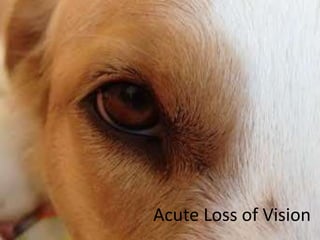
Is it central or peripheral loss of vision
- 1. Acute Loss of Vision
- 2. Questions to Ask on Presentation • When did this happen? • What was your pet doing when it happened? • Have you noticed your pet having difficulty getting around lately? • Describe why you think your pet is blind • Does your pet have a history of seizures? • Does your pet have a history of glaucoma? • Is your cat on any medications? • Have you noticed polyuria, polydipsia, lethargy, ravenous appetite in the past 2 weeks?
- 3. Visual Pathway • Photon of light Retina (rods and cones) converted to an electrical impulse bipolar cells ganglion cells Optic Nerve (CN II) optic nerve enters the calvarium optic chiasm (crosses over) terminate in the lateral geniculate nucleus (20% diverge to generate the PLR) terminate in the visual cortex of the occipital lobes of the cerebrum
- 4. Ophthalmology Examination • Observation – Watch the animal navigate objects in a new environment, obstacle course or track moving objects – Stand behind the animal and throw cotton balls to the side and see if the animal can track them – Ask the owner a history of what the animal has been doing at home
- 5. Ophthalmology Examination • Menace Response – Learned response – CN II – CN VII – Cerebellum • Ipsilateral loss of menace
- 6. Ophthalmology Examination • Visual placing response – Hold patient to edge of table and a normal patient should see the table and place limbs on top • Dazzle Reflex (CN II and VII) – Shine a bright light into the eyes, should blink – Loss of dazzle implies a subcortical lesion – Can be blind and have a dazzle • Intra-ocular pressure – Acute glaucoma causing cupping of optic nerve • Electrophsysiological evaluation of the visual system – Electroretinography
- 7. Ophthalmology Examination • Pupillary light Reflex – Nerve fibers responsible for vision and the fibers mediating PLR have a common pathway to the level of the optic tract – PLR ≠ vision, can have loss of vision and present PLR – Afferent arm: vision loss and direct PLR deficit present – Efferent arm: no vision loss, direct or consensual deficit present – Cortical: vision loss, no PLR deficit
- 8. ...is it central or peripheral loss of vision? So you’ve determined there is a loss of vision…
- 9. Peripheral Causes of Loss of Vision • Lesion of the – Retina – Optic disc – Optic nerve – Optic chiasm • Bilateral or unilateral – Unilateral: pupils will be normal size (indirect response from the good eye will continue to control the pupil of the blind eye) – Bilateral: pupils will be dilated • Loss of afferent information, loss of direct or consensual PLR
- 10. Differential Diagnosis: Peripheral Optic Nerve, disc, chiasm Retina • Optic nerve tumor (neoplasia, granuloma, abscess) • Optic neuritis • Traumatic Optic Neuropathy • Ischemic Optic Neuropathy • Optic nerve hypoplasia • Glaucoma • Coloboma • Retinal degeneration – Progressive retinal atrophy – Sudden acquired retinal degeneration – Enrofloxacin associated retinal degeneration in cats • Retinal detachment – Serous (hypertension) – Rhegmatogenous • Chorioretinitis • Immune mediate retinitis
- 11. Differential Diagnosis: Peripheral Optic Nerve, disc, chiasm Retina • Optic nerve tumor (neoplasia, granuloma, abscess) • Optic neuritis • Traumatic Optic Neuropathy • Ischemic Optic Neuropathy • Optic nerve hypoplasia • Glaucoma • Coloboma • Retinal degeneration – Progressive retinal atrophy – Sudden acquired retinal degeneration – Enrofloxacin associated retinal degeneration in cats • Retinal detachment – Serous (hypertension) – Rhegmatogenous • Chorioretinitis • Immune mediate retinitis
- 12. Optic Neuritis • Loss of vision • Mydriasis • Swollen optic nerve head, elevated disc, peripapillary hemorrhage • Causes: infections, idoipathic, neoplastic, GME, Pug encephalitis • Treatment: CNS wok-up, prednisolone possibly
- 13. Glaucoma • Cupping of the optic nerve • Causes: Chronic glaucoma, acute lens luxation • Tx: Emergency glaucoma treatment! – Mannitol – Dorzolamide ? • Sequelae: degeneration
- 14. Sudden acquired retinal degeneration, SARD • Acute death of photoreceptors • Blindness develops over a few days to weeks • PU, PD, PP, lethargy Cushings • Mydriasis with normal appearing fundus at first • No treatment
- 15. Retinal Detachment • Separates between layers 9 and 10 • Serous – Fluid, cells – Inflammatory, hypertension • Rhegmatogenous – Cataract – Lens luxation • Mydriasis if bilateral • Visioin loss • White tissue elevated into vitreous • Can reattach retina with surgery
- 16. Central Causes of Loss of Vision • Lesion of the optic tract, the lateral geniculate in the thalamus, optic radiation and occipital cortex • Pupil size and responsiveness remains normal • Unilateral lesion: loss is in the contralateral visual field
- 17. Differential Diagnosis: Central • Optic tract • Lateral geniculate in the thalamus • Optic radiation • Occipital cortex
- 18. Questions?
- 19. References • Ophthalmology Notes, VCS 81500, Dr. Townsend and Dr. Stiles • Sturges, Dr. Beverly K. Neuro-ophthalmology: The Visible Nervous System. 2nd Annual Veterinary Neurology Symposium, University of California, Davis. 2005. • Grozdanic, Sinisa et. al., Antibody-mediate Retinopathies in Canine Patients: Mechanism, Diagnosis, and Treatment Modalities. Vet Clin Small Anim 38 (2008) 361-387. • Gould, D.J et.al., Canine Monocytic ehrlichiosis presenting as acute blindness 36 months after importation into the UK. Journal of Small Animal Practive, Vol 41, June 2000. • Gelatt, Kirk, et. al., Enrofloxacin-associated retinal
